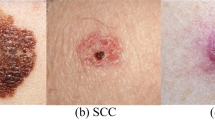Abstract
The timely and accurate diagnosis and treatment of skin cancer are crucial as it is a common and potentially deadly condition. One effective machine learning technique for accurately classifying skin lesions and improving skin cancer diagnosis is known as convolutional neural networks (CNNs). The article offers a detailed examination of the machine learning and CNN techniques employed for skin cancer classification. The discussion includes several studies that have utilized these methods to classify various types of skin lesions, such as basal cell carcinoma, melanoma, and squamous cell carcinoma. Nevertheless, the lack of high-quality datasets presents a significant challenge in skin cancer classification. To address this problem, one of the large-scale datasets developed is the ISIC dataset, which features over 20,000 annotated images of skin lesions. Skin cancer classification has been tackled using different machine learning algorithms, such as decision trees, support vector machines, random forests, as well as CNNs. CNNs are particularly useful for accurately classifying skin lesions because they can learn complex features from images. Several studies have utilized pre-trained CNNs, such as VGGNet and Inception, to classify skin lesions, achieving high accuracy rates of 85–95%. Ensemble methods, such as bagging and boosting, have also been used to improve skin cancer classification accuracy. These methods combine the predictions of multiple models to achieve better performance than a single model. Transfer learning has been effective in reducing overfitting and improving model generalization performance. This review also highlights studies that have utilized multi-modal data, such as dermoscopy and clinical images, to improve skin cancer classification accuracy by providing complementary information about skin lesions.
Access this chapter
Tax calculation will be finalised at checkout
Purchases are for personal use only
Similar content being viewed by others
References
Gavrilov D, Lazarenko L, Zakirov E (2019) AI recognition in skin pathologies detection. In: 2019 International conference on artificial intelligence: applications and innovations (IC-AIAI), 2019, pp 54–542. https://doi.org/10.1109/IC-AIAI48757.2019.00017
Lin C-H, Lin C-S, Chou P-Y, Hsu C-C (2021) An Efficient data augmentation network for out-of-distribution image detection. IEEE Access 9:35313–35323. https://doi.org/10.1109/ACCESS.2021.3062187
Mishra J, Ghosh S, Raj A (2013) Uncertain query processing using vague sets: a better approach. In; Third international conference on computational intelligence and information technology (CIIT 2013), 2013, pp 52–60. https://doi.org/10.1049/cp.2013.2572
Bagchi S, Banerjee A, Bathula DR (2020) Learning a meta-ensemble technique for skin lesion classification and novel class detection. In: 2020 IEEE/CVF conference on computer vision and pattern recognition workshops (CVPRW), 2020, pp 3221–3228.https://doi.org/10.1109/CVPRW50498.2020.00381
Shang H, Sun Z, Fu X, Zhang Z, Yang W (2019) What and how other datasets can be leveraged for medical imaging classification. In: 2019 IEEE 16th International symposium on biomedical imaging (ISBI 2019), 2019, pp 814–818. https://doi.org/10.1109/ISBI.2019.8759148
Reichrath J, Leiter U, Garbe C (2014) Epidemiology of melanoma and nonmelanoma skin cancer—the role of sunlight. In: Reichrath J (ed) Sunlight, vitamin D and skin cancer. Springer, New York, NY, 89–103
Takiddin A, Schneider J, Yang Y, Abd-Alrazaq A, Househ M (2021) J Med Internet Res. https://www.jmir.org
Abuared N, Panthakkan A, Al-Saad M, Amin SA, Mansoor W (2020) Skin cancer classification model based on VGG 19 and transfer learning. In: 2020 3rd International conference on signal processing and information security (ICSPIS), pp 1–4
Amelio A, Pizzuti C (2013) A genetic algorithm for colour image segmentation. In 16th European conference on applications of evolutionary computation, evoapplications 2013, pp 314–323
Arbelaez P, Maire M, Fowlkes C, Malik J (2011) Contour detection and hierarchical image segmentation. IEEE Trans Pattern Anal Mach Intel l, 33(5):898–916
Tschandl M et al (2018) Skin cancer classification using deep learning neural networks. J Am Acad Dermatol 78(6):1170–1172
Esteva A, Kuprel B, Novoa R et al (2017) Dermatologist-level classification of skin cancer with deep neural networks. Nature 542:115–118. https://doi.org/10.1038/nature21056
Yu Y et al (2018) Skin lesion classification using hybrid deep neural networks. J Imaging 4(11):134
Author information
Authors and Affiliations
Corresponding author
Editor information
Editors and Affiliations
Rights and permissions
Copyright information
© 2023 The Author(s), under exclusive license to Springer Nature Singapore Pte Ltd.
About this paper
Cite this paper
Patel, N., Marathe, A., Jasani, V., Rathod, M. (2023). Skin Cancer Classification Using Machine Learning and Convolutional Neural Networks. In: Fong, S., Dey, N., Joshi, A. (eds) ICT Analysis and Applications. ICT4SD 2023. Lecture Notes in Networks and Systems, vol 782. Springer, Singapore. https://doi.org/10.1007/978-981-99-6568-7_44
Download citation
DOI: https://doi.org/10.1007/978-981-99-6568-7_44
Published:
Publisher Name: Springer, Singapore
Print ISBN: 978-981-99-6567-0
Online ISBN: 978-981-99-6568-7
eBook Packages: Intelligent Technologies and RoboticsIntelligent Technologies and Robotics (R0)




